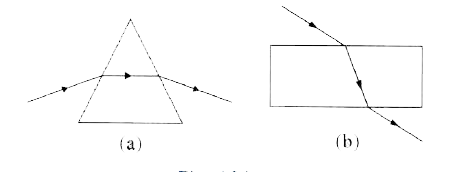Complete Solutions to EXERCISE-4(B) of chapter REFRACTION OF LIGHT AT PLANE SURFACES of Class 10 book with complete answers and questions
| Class 10 | PHYSICS |
| Chapter | REFRACTION OF LIGHT AT PLANE SURFACES |
| SELINA PUBLICATION | EXERCISE-4(B) |
| Number Of Questions | 19 |
| Academic Year | 2023-24 |
What is prism? With the help of a diagram of the principal section of a prism, indicate its refracting surface, refracting edge and base.
View SolutionDiagram (a) and (b) in figure below show the refraction of a ray of light of single colour through a prism and a parallel sided glass slab respectively.

(i) In each diagram, label the incident, refracted, emergent rays and the angle of deviation.
(ii) In what way the direction of the emergent ray in the two cases differ with respect to the incident ray ? explain your answer.
View SolutionDefine the term angle of deviation.
View SolutionComplete the following sentence :
Angle of deviation is the angle which the ____ray makes with the direction of _____ray.
View SolutionWhat do you understand by the deviation produced by a prism? Why is it caused ? State three factors on which the angle of deviation depends.
View Solution(a) How does the angle of deviation produced by a prism change with increase in the angle of incidence. Draw a curve showing the variation in the angle of deviation with the angle of incidence at a prism surface.
(b) Using the curve in part (a) above, how do you infer that for a given prism, the angle of minimum deviation `delta_("min")` is unique for a given light.
View SolutionState whether the following statement is 'true' or 'false'.
The deviation produced by a prism is independent of the angle of incidence and is same for all colours of light.
View SolutionHow does the deviation produced by a prism depend on (i) the refractive index of its material, and (ii) the wavelength of incident light.
View SolutionHow does the angle of minimum deviation produced by a prism change with increase in (i) the wavelength of incident light, and (ii) the refracting angle of prism ?
View SolutionWrite a relation for the angle of deviation `(delta)` for a ray of light passing through an equilateral prism in terms of the angle of incidence `(i_(1))`, angle of emergence `(i_(2))` ang angle of prism (A).
View SolutionA ray of light incident at an angle of incidence `i_(1)` passes through an equilateral glass prism such that the refracted ray inside the prism is parallel to its base and emerges at an angle of emergence `i_(2)`.
(i) How is the angle of emergence `'i_(1)'` related to the angle of incidence `'i_(1)'` ?
(Ii) What can you say about the angle of deviation in such a situation ?
View SolutionDraw a ray diagram to show the refraction of a monochromatic ray through a prism when it suffers minimum deviation. How is the angle of emergence related to the angle of incidence in the position.
View SolutionA light ray of yellow colour is incident on an equilateral glass prism at an angle of incidence equal to `48^(@)` and suffers minimum deviation by an angle of `36^(@)`. (i) What will be the angle of emergence ?
(ii) If the angle of incidence is changed to (a) `30^(@)`
(b) `60^(@)`, state in each case whether the angle of deviatioin will be equal to, less than or more than `36^(@)`. ?
View SolutionName the colour of white light which is deviated (i) the most, and (ii) the least, on passing through a prism.
View SolutionWhich of the two prisms, A made of crown glass and B made of flint glass, deviates a ray of light more ?
View SolutionHow does the angle of deviation depend on the refracting angle of the prism?
View SolutionAn object is viewed through a glass prism with its vertex pointing upwards. Draw a ray diagram to show the formation of its image as seen by the observer.
View SolutionA ray of light is normally incident on one face of an equilateral glass prism. Answer the following :
(a) What is the angle of incidence on the first face of the prism?
(b) What is the angle of refraction from the first face of the prism ?
(c) What will be the angle of incidence at the second face of the prism ?
(d) Will the light ray suffer minimum deviation by the prism ?
View SolutionFigure below shows two identical prisms A and B placed with their faces parallel to each other. A ray of light of single colour PQ is incident at the face of the prism A. complete the diagram to show the path of the ray till it emerges out of the prism B.

View Solution
EXERCISE-4(B) questions and complete solutions for chapter REFRACTION OF LIGHT AT PLANE SURFACES of SELINA PHYSICS (ENGLISH) of Class 10